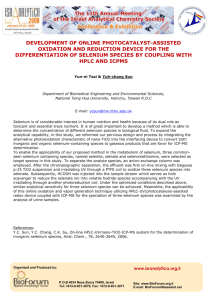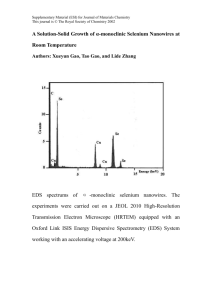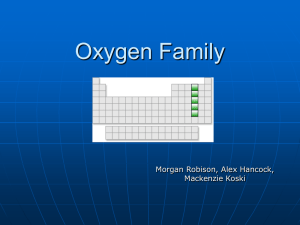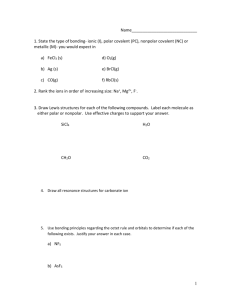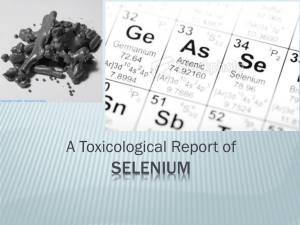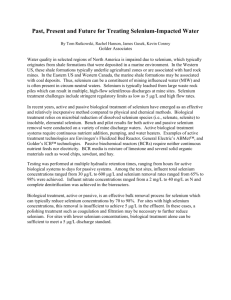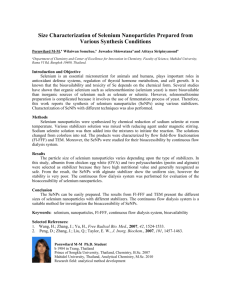N e w
advertisement
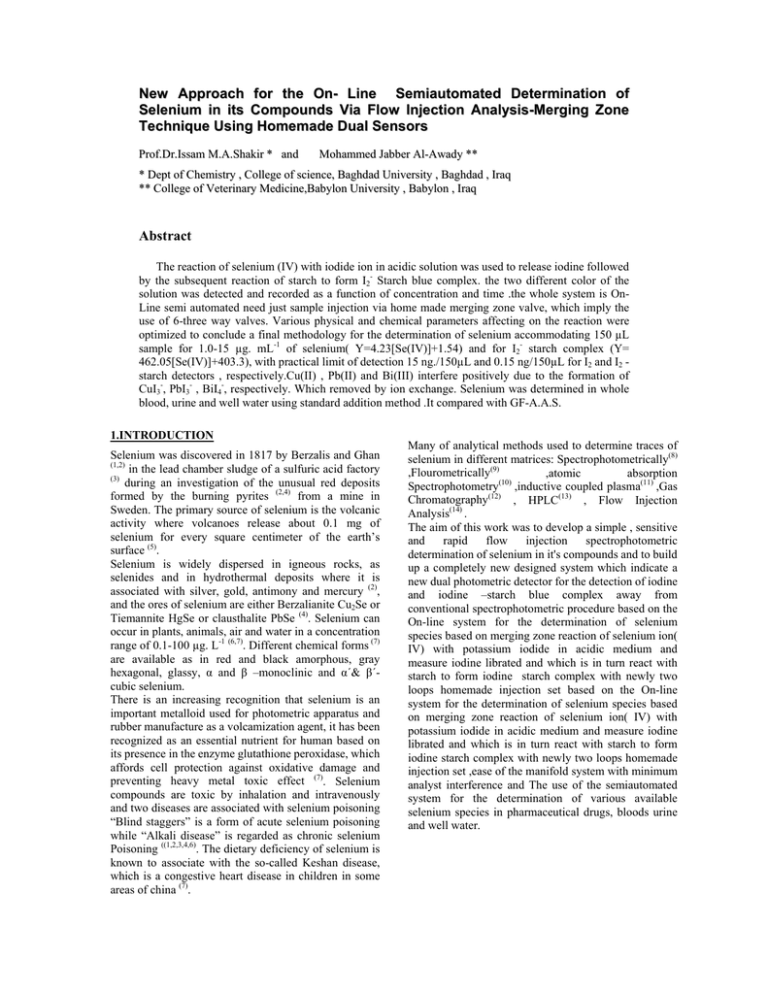
New Approach for the On- Line Semiautomated Determination of Selenium in its Compounds Via Flow Injection Analysis-Merging Zone Technique Using Homemade Dual Sensors Prof.Dr.Issam M.A.Shakir * and Mohammed Jabber Al-Awady ** * Dept of Chemistry , College of science, Baghdad University , Baghdad , Iraq ** College of Veterinary Medicine,Babylon University , Babylon , Iraq Abstract The reaction of selenium (IV) with iodide ion in acidic solution was used to release iodine followed by the subsequent reaction of starch to form I2- Starch blue complex. the two different color of the solution was detected and recorded as a function of concentration and time .the whole system is OnLine semi automated need just sample injection via home made merging zone valve, which imply the use of 6-three way valves. Various physical and chemical parameters affecting on the reaction were optimized to conclude a final methodology for the determination of selenium accommodating 150 µL sample for 1.0-15 µg. mL-1 of selenium( Y=4.23[Se(IV)]+1.54) and for I2- starch complex (Y= 462.05[Se(IV)]+403.3), with practical limit of detection 15 ng./150µL and 0.15 ng/150µL for I2 and I2 starch detectors , respectively.Cu(II) , Pb(II) and Bi(III) interfere positively due to the formation of CuI3-, PbI3- , BiI4-, respectively. Which removed by ion exchange. Selenium was determined in whole blood, urine and well water using standard addition method .It compared with GF-A.A.S. 1.INTRODUCTION Selenium was discovered in 1817 by Berzalis and Ghan (1,2) in the lead chamber sludge of a sulfuric acid factory (3) during an investigation of the unusual red deposits formed by the burning pyrites (2,4) from a mine in Sweden. The primary source of selenium is the volcanic activity where volcanoes release about 0.1 mg of selenium for every square centimeter of the earth’s surface (5). Selenium is widely dispersed in igneous rocks, as selenides and in hydrothermal deposits where it is associated with silver, gold, antimony and mercury (2), and the ores of selenium are either Berzalianite Cu2Se or Tiemannite HgSe or clausthalite PbSe (4). Selenium can occur in plants, animals, air and water in a concentration range of 0.1-100 µg. L-1 (6,7). Different chemical forms (7) are available as in red and black amorphous, gray hexagonal, glassy, α and β –monoclinic and α´& β´cubic selenium. There is an increasing recognition that selenium is an important metalloid used for photometric apparatus and rubber manufacture as a volcamization agent, it has been recognized as an essential nutrient for human based on its presence in the enzyme glutathione peroxidase, which affords cell protection against oxidative damage and preventing heavy metal toxic effect (7). Selenium compounds are toxic by inhalation and intravenously and two diseases are associated with selenium poisoning “Blind staggers” is a form of acute selenium poisoning while “Alkali disease” is regarded as chronic selenium Poisoning ((1,2,3,4,6). The dietary deficiency of selenium is known to associate with the so-called Keshan disease, which is a congestive heart disease in children in some areas of china (7). Many of analytical methods used to determine traces of selenium in different matrices: Spectrophotometrically(8) ,Flourometrically(9) ,atomic absorption Spectrophotometry(10) ,inductive coupled plasma(11) ,Gas Chromatography(12) , HPLC(13) , Flow Injection Analysis(14) . The aim of this work was to develop a simple , sensitive and rapid flow injection spectrophotometric determination of selenium in it's compounds and to build up a completely new designed system which indicate a new dual photometric detector for the detection of iodine and iodine –starch blue complex away from conventional spectrophotometric procedure based on the On-line system for the determination of selenium species based on merging zone reaction of selenium ion( IV) with potassium iodide in acidic medium and measure iodine librated and which is in turn react with starch to form iodine starch complex with newly two loops homemade injection set based on the On-line system for the determination of selenium species based on merging zone reaction of selenium ion( IV) with potassium iodide in acidic medium and measure iodine librated and which is in turn react with starch to form iodine starch complex with newly two loops homemade injection set ,ease of the manifold system with minimum analyst interference and The use of the semiautomated system for the determination of various available selenium species in pharmaceutical drugs, bloods urine and well water. 2.EXPERIMENTAL 2.1Chemicals All chemicals Used were of analytical grade reagents; used without any further purification. Selenium stock solution (1000 µg. mL1 ) was prepared by dissolving 1.4052 g of selenium dioxide SeO2 (BDH) in distilled water and diluting to 1 Lvolumetric flask. Working solutions were prepared by appropriate dilution of the stock solution with distilled water. - Potassium Iodide (0.1 mol L-1) was prepared by dissolving 16.6g of potassium Iodide KI (BDH) in distilled water and diluting to 1 L-volumetric flask. Working solutions were prepared by appropriate dilution of the stock solution with distilled water. - Hydrochloric acid solutions (1.0 mol. L-1) was prepared by pipetting 98.2 ml of concentrated hydrochloric acid (HCl) (Fluka) and complete the volume to 1 L-volumetric flask and standardized with 0.5 mol.L-1 Anhydrous sodium Carbonate. - Soluble starch Solution (1%) was prepared by dissolving 10g of soluble starch (BDH) in a little of distilled water and complete the volume with boiling distilled water to 1 Lvolumetric flask and boil the solution for 5 min. and stay the solution stable for one weak. - - - Sulfuric acid solution (1 mol. L-1) was prepared by pipetting 17.91ml of concentrated sulfuric acid (Fluka) and complete the volume with distilled water to 100 ml- volumetric flask. Working solutions were prepared by appropriate dilution of the stock solution with distilled water. Nitric acid solution (1 mol. L-1) was prepared by pipetting 14.4 ml of concentrated Nitric acid (Fluka) and complete the volume with distilled water to 100 ml- volumetric flask. Working solutions were prepared by appropriate dilution of the stock solution with distilled water. Acetic acid solution (1 mol. L-1) was prepared by pipetting 17.38 ml of concentrated acetic acid (BDH) and completed the volume to 100 mlvolumetric flask. Working solutions were prepared by appropriate dilution of the stock solution with distilled water. - - - - - - - - Orthophosphuric acid solution (1 mol. L-1) was prepared by pipetting 14.65 ml of concentrated Orthophosphuric acid (Fluka AG) and completed the volume with distilled water to 100 ml-volumetric flask. Working solutions were prepared by appropriate dilution of the stock solution with distilled water. Perchloric acid concentrated (Fluka AG), 70%, Sp. gr. 1.67, M.wt. 100.46 gm/mol. Nitric acid concentrated (Fluka AG), 65%, and Sp. gr. 1.4, M.wt. 63.01 gm/mol. Ascorbic acid (0.1 mol. L-1) was prepared daily by dissolving 1.7613g of ascorbic acid (Fluka AG) in distilled water and diluting with distilled water to 100 ml- volumetric flask. Formic acid solution (11.5%) was prepared by diluting 11.5 ml. of concentrated formic acid (Fluka AG) with distilled water to 100 ml –volumetric flask. Hydrochloric acid solution (1:1) was prepared by diluting 50 ml of concentrated hydrochloric flask with distilled water to 100 ml volumetric flask. Sodium Hydroxide (4%) was prepared by dissolving 4.0g of sodium hydroxide (BDH) in distilled water and diluted with distilled water to 100 ml-volumetric flask. 3,3`-diaminobenzidine (0.5%) was prepared by dissolving 0.5g of 3,3`-diaminobenzidine. tetrahydrochloride (sigma-U.S.A) in distilled water and diluted with distilled water to 100ml- volumetric flask. Ammonium hydroxide solution (1:1) was prepared by diluting 50 ml of concentrated ammonia solution (BDH) with distilled water to 100ml- volumetric flack. Toluene (Fluka) spectrophotometric grade. Interferring ions Solutions Different solutions of Cations and Anions (500 µg. ml-1) were prepared by dissolving a known amount of interfering ion in distilled water and completing the volume to 250 ml– volumetric flask with distilled water, and working solutions were prepared by appropriate dilution of the stock solution with distilled water. Organic compounds (1000µg. ml-1) were prepared by dissolving 0.25 g of each compound in distilled water with 2.0 ml of conc. HCl and complete the volume to 250 ml. volumetric flask. 2.2 Apparatus - Compressor (PYE UNICAM) 3.5 Kg. Cm-2. - Peristaltic Pump LKB Bromma 2120 Varioperspex (Sweden). - Home made double loop 8-Port Injection valves(15) - Home made flow through cell (2mm width) and dual sensors. - X-t- Potentiometric Recorder (servogor Z10). - X-t- Potentiometric Recorder (Varian Aerograph- USA). - - Digital Recorder DT 830B digital multimeter (China). Double beam UV-visible spectrophotometerShimadzu 160 (Japan). RC-filter (0.68 & 0.1 sec). PH-meter-WTW pH 521/ Wissenschaftlich-Technische werkstatten (Germany) Sensitive balance (Mettler- Switzerland). Electrothermal AAS-Shimadzu AA 680 G (Japan). Which Consist of: a- Power supply (GFA-4B). b- Graphite furnace (GFA-4B). c- Auto sample changer (ASC060G). d- Graphite printer (PR-4). Y-shape connection. Capillary tubes were made from polypropylene or Teflon (1.0mm id & 1.2 mm o.d). Nipples for linking tubes. Reaction Coil was made from glass (2mm-id & 3.5 mm O.D). Medical syringe (5ml & 10 ml). UV-Visible spectrophotometer (CECIL, USA) Detection was conducted by measurement of On-Line absorbance or plus turbidity for the released iodine or precipitated non-settled precipitate of selenium metal through I2-detection while the second detector measures the absorbance of blue color complex of Iodinestarch and the turbidity of coagulated blue-sediment I2starch or/ and I2-starch –selenium metal precipitate. Factors affecting absorbance of released iodine or I2-starch blue complex. The chemicals used for conduction of the reaction in which iodine is released for the determination of selenium were potassium iodide and hydronium ion. Therefore, many parameters were studied in order to obtain optimum concentration and higher response intensity via the use of single variable. 2.3 COMPARISON METHODES *Extraction method) (16). spectrophotometry (Reference A wide used method uses the reaction between selenium (IV) ion and 3,3′-diaminobenzidine, which forms the compound diphenylpiazselenol. Beer’s law is obeyed over the range 1-10 µg.ml-1 at 420 nm with a correlation coefficient of 0.9977. It follows a Linear regression equation of Abs. =0.037 (Se4+) + 0.0489. Procedure: to a sample containing not more than 0.05 mg Se ,2ml of 11.5%of formic acid was added and diluted with distilled water to about 50 ml. 1:1 hydrochloric acid or 4% sodium hydroxide was to adjust the pH to 2-3. 2ml of a 0.5% solution of 3,3-diaminobenzidine tetra hydrochloride and it was let stand for 30-50 min for color development and then pH was raised to 6-7 by adding 1:1 ammonium hydroxide. The solution was transferred to a 125-ml separatory funnel and was extracted with 10 ml of toluene. The absorbance was read at 420 nm against reagent blank. ** Iodometric spectrophotometry Using spectrophotometric determination of the released iodine by conventional spectrophotometric, it shows a linear calibration graph at 350 nm extended from 0-1 µg. ml-1 with a correlation coefficient of 0.9954. It follows a linear regression equation of Abs. =0.06 +1.46 (Se4+). 3.RESULTS AND DISCUSSION The reaction between selenium (IV) ion and iodide ion in acidic medium was used in which iodine is released. The released iodine was measured via the I2-detector. The outlet of which reacts with starch solution feed to form the I2-starch blue complex which is measured in the second detector. (it shows in the whole flow gram manifold Fig .1) as in the following equation: SeO2+ 4KI+ 4HCl→ Se↓+2I2 + 2H2O+4KCl EReduction(175)= 0.75V Fig 1: Flowgram of the whole manifold with dual detectors and double loop -6- three way valve The flow injection manifold depicted in Fig.1 was investigated in the relation to chemical and flow variables, in order to obtain optimum conditions for the system .They were optimized by making all variables constant and varing one each at a time. 3.1 Choice of Acid The reaction of Se (IV) and iodide ion can be conducted in acidic medium: Therefore, different acids (HCl, H2SO4, H3PO4 and CH3COOH) were used at various concentrations. Nitric acid was avoided in this study as it affected the release of iodine. The use of a 1.0 mol. L-1 of hydrochloric acid as a carrier stream at 2.5 ml. min-1, 0.1 mol. L-1 of 275 µl of potassium iodide, 150 µl of 10 µg. ml-1 of selenium (IV) ion and 1% soluble starch solution as a second line carrier stream at 1.0 ml.min-1 Fig-2A- shows the variation of absorbance expressed as average peak height (n=3) in mV with different acids used for the released iodine in the first flow cell using the first detector. Fig-2B shows the variation of absorbance of the I2-starch detector and Fig 2 shows that hydrochloric acid was chosen as a favorable acid at I2 and I2-starch detectors. 3.2 Effect of concentration of potassium iodide Solution Various concentrations (1*10-2 mol-1-6*10-1 mol. L) of potassium iodide solution were used to establish the optimum potassium iodide solution concentration that can be used in second loop (275 µl). The study was conducted using 150 µl of 15 µg. ml-1 of selenium (IV) ion, 1.0mol. L-1 of hydrochloric acid as a carrier stream at 2ml. min-1. L-1 and 1% of soluble starch solution at 1ml. min-1. Fig 3.18 shows the variation of absorbance expressed as average peak height (n=3) in mV with the molar concentration of KI solution at the first and the second flow cell which shows clearly that 0.1mol. L-1 of KI solution is a compromise for the signals obtained from both detectors. Table no.-3A, 3B –shows the effect of variation of absorbance expressed as peak height (n=3) in mV with various concentration at I2detector and I2-starch detector respectively. (A) 1 A b s o rb a n c e e x p re s s e d a s a v e ra g e p e a k h e ig h t(m V ) CHEMICAL AND FLOW OPTIMIZATION A 80 60 40 20 0 0 0.2 0.4 0.6 0.8 Concentration of KI (mol/L) B A b s o rb a n c e e x p re s s e d a s a v e ra g e p e a k h e ig h t(m V ) (B) 6000 5000 4000 3000 2000 1000 0 0 0.2 0.4 0.6 0.8 Concentration of KI (mol/L) Fig 3: Effect of variation of absorbance versus molar concentration of KI at (A) I2- detector (B) I2starch detector. 3.3 Effect of concentration Fig 2: The variation of absorbance of the first and the second detectors expressed as average peak height (n=3) in mV versus concentrations of acids and it types. (A) I2-detector (B) I2- starch detector. hydrochloric acid solution Various concentrations (0.1 mol. L-1-6 mol. L-1) of hydrochloric acid solution were used to obtain the optimum concentration of hydrochloric acid that can be used as a carrier stream at 2.0 ml. min -1 using 150µl of 10 µg ml-1 of selenium (IV) ion, 275 µl of 0.1 mol. L-1 of potassium iodide and 1% of soluble starch solution at 1 ml. min-1 as a second carrier stream. Fig 4 shows the variation of absorbance expressed as average peak height (n=3) in mV versus the molar concentration of hydrochloric acid which shows clearly that 1.0 mol. L-1 of hydrochloric acid is a compromise at two detectors. (B) Absorbance expressed as average peak height (mV) A bs orba nc e e x pre s s e d a s a v e ra ge p e a k h e ig h t (m V ) (A) 200 150 100 50 0 0 0.5 1 1.5 2 % soluble starch 0 2 4 6 8 Concentration of HCl (mol / L) Fig 5: The variation of absorbance (mV) versus starch solution concentration. (A) Absorbance- starch solution concentration (%) profile. (B) The variation of absorbance expressed as average peak height (n=3) in mV versus starch solution concentration (%). (B) A b s o rb a n c e e x p re s s e d a s a v e ra g e p e a k h e ig h t (m V ) 6000 5000 4000 3000 2000 1000 0 4000 3000 3.5 The effect of Hydrochloric acid flow rate The effect of hydrochloric acid fow rate was also investigated in the range of 1.0 – 4.5 ML/Min to obtain the best peak height where hydrochloric acid flow rate of 2.0 ML/Min gave the highest response at Iodine and Iodine – Starch detectors. 2000 1000 0 0 2 4 6 8 Concentration of HCl (mol / L) Fig 4: The variation of absorbance expressed as average peak height (n=3) in mV versus concentrations of Hydrochloric acid solution (A) I2-detector (B) I2- starch detector. 3.4Effect of concentration soluble starch A solution Various concentrations (0.1%-1.5%) of soluble starch solution were used at flow rate 1.0 ml. min-1 using 150 µl of 10 µg. ml-1 of potassium iodide and 1.0 mol. L-1 of hydrochloric acid at 2.0ml. min-1 as a main carrier stream where the concentration of soluble starch solution will affect the viscosity of the starch feed solution which in turn affects the flow rate; therefore, a compromise between starch solution concentration and flow rate must be adjusted in order to have maximum sensitivity and smooth profile for absorbance versus concentration signal. Fig 5 shows (A) Absorbance- starch solution concentration (%) profile and 0.2% can be selected as an optimum value. (B). The variation of absorbance is expressed as average peak height (n=3) in mV versus soluble starch solution concentration (%). B A Fig 6: The variation of absorbance (mV) versus flow rate of hydrochloric acid at I2-and I2 –starch detectors, respectively( Absorbance- flow rate (ml. min-1) profile ) 3.6 The effect of Physical parameters (flow rate of starch solution, reaction coil length and iodide solution volume ) were investigated .The effect of sample volume was studied as A set of injected volumes of iodide ion varied between (100-300µl) by changing the length of iodide loop (L2) using 150 µl of 15 µg. m1-1 of sample, 1.0 mol. L-1 of hydrochloric acid at 2.0 ml. min-1 as a main carrier stream, 0.2% of starch solution at 1.0ml.min-1 and 100-cm reaction Coil length. Fig 7 shows absorbance (mV)-Iodide volume (ml) profile at Iodine and I2-starch detectors, respectively. Volume of 275 µl of potassium iodide in loop (L2) was chosen as an optimum value. A B 4. Calibration Curve and Statistical Data Using the optimum parameters achieved in previous sections, summarized in Table no. 1 dealing with the chosen concentration of reactants or flow rates, a series of solutions containing 0.01-20 µg.ml-1 of selenium dioxide was prepared by appropriate dilution of 1000 µg ml-1 selenium prepared and diluted to the mark of the volumetric flask (all necessary precautions were adapted through this work). Fig 8 shows the variation of absorbance of released iodine expressed as average peak height (n=3) in mV with selenium concentration (µg. ml-1) at Linear dynamic range extended from (1-15) µg. ml-1. Fig 9 and Fig 10 show the variation of absorbance of I2-starch blue complexes expressed as average peak height (n=3) in mV with selenium concentration (µg. ml-1) at two Linear dynamic range from (0.01-5 µg. ml-1) and (1-15 µg. ml-1), respectively, depending on the variation of incident light intensity at 25% and 70% of the full intensity for each of I2 and I2starch detectors. Table 2 tabulates the linear part of the absorbance versus concentration curve, which shows a linear dynamic range with linearity for the measurement of released iodine. It also tabulates the analytical data obtained from the I2-starch detector for two linear range obtained at two different intensities of incident radiation. Table 1: The optimization of the chemical and FIA parameters using merging zones- flow injection analysis for the determination of selenium Optimum Parameter value HCl concentration 1.0 mol. L-1 KI concentration 0.1 mol L-1 Starch solution 0.2 gm/ 100ml concentration Fig 7: The variation of absorbance (mV) versus sample volume (µl) profile (A) I2 -detector (B)I2Starch detector. Flow rate of HCL 2.0 ml. min-1 Flow rate starch 1.0 ml. min-1 Sample volume (µl) 150 µl Iodide volume (µl) 275 µl Reaction Coil length (cm) 100 cm Table 2: Analytical Characteristics of the calibration graphs for the determination of Selenium 7 7 7 Absorbance expressed as average peak height (mV) Iodine I2-starch I2-starch 1-15 0.01-0.5 1-15 Intercept at Slope at 95% 95% confidence confidence Limit for (n=3) Limit for (n=3) 4.2257±0.103 1.537±0.9287 1011.3±64.4035 40.477±18.212 462.05±10.985 403.32±97.732 60 40 20 0 0 5 10 15 20 Selenium concentration(Microgram/ml) Absorbance expressed as average peak height(mV) Fig 8: The variation of absorbance of released iodine (mV) versus selenium concentration at (1-15) ppm linear range. 600 500 400 300 200 100 0 ttab. 129.06>>2.571 39.46>>2.571 11.78>>2.571 R % Rz 0.9997 0.9984 0.9998 99.95 99.68 99.96 15 45 46 4.1 Repeatability y = 4.2257x + 1.5375 2 R = 0.9995 80 tcal Sampling rate Linear Type of No. of dynami detector Points c range Repeatability was studied at determination of selenium via measurement of released iodine or I2starch blue complex from system Se4+-I--H3O+ and Se4+-I--H3O+-starch, respectively. Variable concentrations of selenium (IV) ion (4,6 and 10 µg.ml1 ) were injected. Each concentration was injected successfully for five times. Table no. 3.14 tabulates the average, standard deviation and the confidence limit at 95% CL (n-1) for the repeatability of the released iodine and for I2-starch blue complex which shows clearly that relative standard deviation is better than one in most cases can be obtained. Fig 11- shows repeatability of the measurements of selenium as the Absorbance- Time profile. A y = 1011.3x + 40.477 2 R = 0.9969 0 0.1 0.2 0.3 0.4 0.5 0.6 Selenium Concentration(Microgram/ml) A b s o rb a n c e e x p re s s e d a s a v e ra g e p e a k h ie g h t(m V ) Fig 9: The variation of absorbance of I2-starch complex (mV) versus selenium concentration at (0.01-0.5) ppm linear range. B y = 462.05x + 403.32 2 R = 0.9996 8000 6000 4000 2000 0 0 5 10 15 20 Selenium concentration(Microgram/ml) Fig 10: The variation of absorbance of I2-starch complex (mV) versus selenium concentration at (1 -15) ppm linear range. Fig 11: Repeatability of the measurement (4,6 and 10µg.ml-1) of selenium (A) Released iodine (B) I2-starch complex 4.2 Limit of Detection Limit of detection (17) can be defined as the concentration that produces an absorption signal equivalent to blank solution. While, the recent definition of detection limit in analytical chemistry is the concentration, or absolute amount, of analyte required to give a signal equivalent to three times standard deviation of the blank which is represented by (YB+ 3SB) where YB is the intercept and SB is the standard deviation of blank solution. Fig 12 shows Limit of detection for the determination of selenium at I2-starch detector using proposed method. 4.3 Effect of interfering ions To ensure the validity of the proposed method for the determination of selenium, the effects of various foreign ions on the determination of 5 µg.ml-1 of Se (IV) were studied. The results are summarized in tables no. 3, 4 and 5. As it is seen, almost organic compounds, alkali ions and some other Cations and anions have no considerable effect on the determination of selenium (IV). Substances most Likely interfering with the method are oxidizing and reducing agent, which can influence the chemical reaction stoichiometry. Fig 12: Limit of detection for the determination of selenium at the I2-starch detector using proposed method Interfering Ion conc. µg.ml-1 Table no.3: Effect of cation interference on the released iodine. % Interference Cr+++ Cu++ Co2+ Ni2+ pb2+ Ba2+ Ca2+ Mg2+ Na2+ Bi2+ NH4+ Cd2+ 1.fold 2.fold 3.fold -1.16 -4.42 -6.51 25.25 54.92 76.96 0.00 -7.17 -19.19 1.18 1.70 -6.51 32.09 79.71 165.29 -1.34 -2.78 -4.26 0.00 -3.17 -8.44 0.00 2.39 3.12 0.00 -0.30 -0.32 53.58 150.41 264.35 0.83 6.01 7.67 -13.23 -20.61 -23.70 Table 3 shows that Cu++, pb++, and Bi+++ are interfering much more because they form complexes as CuI3-, pbI3- and BiI4-, respectively. These ions can be removed by ion exchange Table no.4: Effect of anion interference on the Released iodine Interfe ring ion conc. µg.ml-1 1.fold 2.fold 3.fold % Interference IO3- IO4- Cl- Br- S2O3= Co3=2 NO2- MoO4= MnO4- Cr2O7= CrO4- 1.64 16.48 58.24 5..49 42.85 74.72 -4.16 -9.37 -12.50 -51.16 -61.79 -74.41 -87.20 -19.86 -105.20 -6.04 -11.40 -13.19 15.45 54.50 147.25 -70.23 -82.40 -86.97 20.87 80.82 191.79 5.14 14.83 68.13 2.17 16.48 125.57 Table 5: Effect of selected organic molecules on the released iodine Compound conc. µg.ml-1 0.5-fold 1-fold 2-fold Na2EDTA 0.00 0.00 0.00 Acetate -0.90 -1.47 -1.80 Tartrate 0.00 -0.06 -0.18 % interference Citrate Oxalate 0.00 0.00 0.00 0.00 -0.49 -0.23 Cystiene -0.54 -3.36 -5.63 Methionine -3.44 -4.17 -4.52 Removal of Foreign ions Table no.3 shows that cations such as Cu++, pb++ and Bi+++ are very strong interfering ions in the determination of selenium (IV) ion. These ions can be removed by a Cation exchange resin (Na+form). A series of solutions that required for the preparation 5 µg.ml-1 of Se (IV) plus 10 µg.ml-1 or 15 µg.ml-1 of the desired cation were prepared and then passed through a 10-cm Column (0.8cm id and 1.0cm od.) containing the cation exchange resin (H+-form). The column was washed with distilled water and the fluent was collected into a 100-ml volumetric flask. The solution was diluted to the mark with distilled water and the solution was injected. The results are summarized in table no. 6. Table No 6: Treatment of interfering ions using Cation exchange resin. Cation Concentration µg.ml-1 % Interference Cu2+ Pb2+ Bi3+ 10 0 0 0 15 0 0 0.27 Table 7: C`omparison between proposed method and ET-AAS method for the determination of selenium in biological samples and well water Sample Selenium found in samples (µg.ml-1) Merging Zone/ GF-AAS FIA di 0.0588 0.068 0.0092 Urine 0.07 0.068 -0.002 Well water 0.03 0.013 -0.017 Human blood Xd Sd -0.0098 0.0153 tc al. ttab. 1.109<4.303 4.4 Determination of selenium in various samples using invented manifold via standard additions method Five 10 ml–volumetric flask was prepared and 1ml of sample was added for each volumetric flask and after that particular amount of selenium (IV) ion (X=0.1µg. ml-1) was added with (X, 2X, 3X and 4X) for each flasks (2,3,4 and 5), respectively, while the first volumetric flask was only containing the sample. Table no. 7 tabulates the comparison between determination of selenium in a proposed method and in EectroTermalAAS. method for the human blood, urine and well water using paired comparison t-test. 5. Conclusions The work described in this research comprises more than a complete new intuition for a compact home made new dual flow cell with two focused sources of different emission wave length monitored by two twin detector, capable- of detecting of different photon intensities merged from the flow cell. The size of the detection unit dose not exceeds 4* 10-4. Also a new spectrophotometry was used which involve changing the intensity but not wavelength of the incident radiation; which allows a wider dynamic range (i.e.having more than one dynamic range) and a RCfilter for the reduction of noise and signal improvement. To our knowledge no what so ever this technique was used in any published work everywhere else. The simplicity and the mode of working presented in this work and its well comparison with standard spectrophotometric method indicates that the method presented in this research work can be used as an alternative method for the spectrophotometric method, part from its speed, simplicity, reliability. A much further work is in progress using the ON-LINE mode. Acknowledgement The author would like to express his great thanks to Dr.Nagam S.Turkie Al-Awady for her help and conductance of most of the calculations and her unlimited guidance. REFERENCES 1. John Emsley 1998,The elements”, Clarendon press, oxford. 3th edition, 2. Snell-Ehre, 1973 Encyclopaedia of Industrial chemistry, vol. 17,NewYork. 3. H-Remy, 1956 Treatise on Inorganic chemistry, vol. 1-Elsevier publishing CO.,Netherland,. 4. Wilfred W.S., Sc. D, 1939 “standard methods of chemical Analysis”, 5th edition, vol.1., NewYork,. 5. Carla W.M., 1997 “Environmental Geology”. 5th edition MCB McGraw Hill, NewYork,. 6. 7. R.A. Zingaro & W.C. cooper 1974 “Selenium”, van Nostrand Reinhold CO., England,. Eric J.N., 1977 “Trace elements in Human and Animal Nutrition”, 4th edition, Academic Press Oxford,. 8. 9. 10. 11. 12. 13. 14. 15. 16. 17. M.F.Mousavi and A.R.Jahanshahi , 1999,"Determination of Se(IV) in the presence of Se(VI) at NG ML-1 concentration by a kinetic spectrophotometric method " ,Analytical Letters,32(14),2871. K.Takayangi and G.T.F.Wong, 1983,"Flourometric determination of selenium (IV) and total selenium in natural waters",Analytica Chim.Acta,148,263. T.Kubota,K.Suzuki and T.Okutani ,1995,"Determination of total selenium content in sediments and natural water by Graphite furnace atomic absorption spectroscopy after collection as a selenium(IV) complex on activated carbon",Talanta , 42,949 A.Chatterjee,Y.Shibata and M.Morita , 2000"Determination of selenite and selenomethionine by HPLC-HG-High Power n2-MIP-MS:suitable coupling for selenium speciation" ,JAAS,15,913 A.F.Al-Attar and G.Nickless ,1988,1,2 diaminobenzinederivatives for the determination ofselenium by gas chromatograpgy", J. of Chromatography,440,333 M.Kotrebai,J.F.Tyson,E.Block and Peter C.Uden, 2000," HPLC of selenium compounds utilizing perflourinated carboxylic acid ion –pair agents and ICP and electrospray ionization MS detection",J. of chromatography A,866,51. M.J.Ahmed,C.D.Stalikas,S.M.Tzouwara,and M.I.Karaynnis,1998,"simultaneous spectroflourometric determination of selenium(iv) and (vi) by Flow Injection Analysis",Analyst,122,221. I. M. A. Shakir, F. H. Hussein & D. N. Taha, (2002). Patent No. 3153, dec. F. D. Snell & C. T. Snell, (1959) “Colorimetric Methods of analysis”, van Nostrand Co., vol. IIA,. J. C. Miller and J. N. Miller. “Statistics for Anal. chem.”, 2nd edition, John Wily and Sons., New York.
